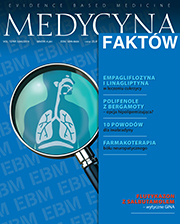Pregabalina i duloksetyna w leczeniu bólu neuropatycznego. Najczęściej pojawiające się pytania i wątpliwości Artykuł przeglądowy
##plugins.themes.bootstrap3.article.main##
Abstrakt
Ból neuropatyczny powstaje w następstwie zaburzenia funkcji obwodowych włókien nerwowych, struktur rdzenia kręgowego lub mózgowia. Obniżeniu ulega próg wzbudzenia komórek nerwowych oraz pojawiają się mechanizmy prowokujące spontaniczne ektopowe wyładowania neuronów. Na poziomie międzykomórkowym zjawiska te są uzależnione od wzmożonej, wywołanej czynnikiem uszkadzającym nerw aktywności glutaminergicznej. Na poziomie subkomórkowym za obniżenie progu wzbudzenia komórek odpowiada zmiana konstelacji przezbłonowych kanałów jonowych, zwłaszcza sodowych i wapniowych. Z tego powodu w jego leczeniu stosuje się leki wpływające na kanały wapniowe (pregabalina) i transmisję noradrenergiczną i serotoninową. W pracy zaprezentowano zasady leczenia oboma preparatami.
##plugins.themes.bootstrap3.article.details##
Copyright © by Medical Education. All rights reserved.
Bibliografia
2. Meacham K., Shepherd A., Mohapatra D.P., Haroutounian S.: Neuropathic Pain: Central vs. Peripheral Mechanisms. Curr. Pain Headache Rep. 2017; 21: 28.
3. Luo Z.D., Chaplan S.R., Higuera E.S. et al.: Upregulation of dorsal root ganglion (alpha)2(delta) calcium channel subunit and its correlation with allodynia in spinal nerve-injured rats. J. Neurosci. 2001; 21: 1868-1875.
4. Cohen S.P., Mao J.: Neuropathic pain: mechanisms and their clinical implications. BMJ 2014; 348: f7656.
5. Wei F., Dubner R., Zou S. et al.: Molecular depletion of descending serotonin unmasks its novel facilitatory role in the development of persistent pain. J. Neurosci. 2010; 30: 8624-8636.
6. Stahl S.M., Porreca F., Taylor C.P. et al.: The diverse therapeutic actions of pregabalin: is a single mechanism responsible for several pharmacological activities? Trends Pharmacol. Sci. 2013; 34: 332-339.
7. Kumar N., Laferriere A., Yu J.S.C. et al.: Evidence that pregabalin reduces neuropathic pain by inhibiting the spinal release of glutamate. J. Neurochem. 2010; 113: 552-561.
8. Takasusuki T., Yaksh T.L.: The effects of intrathecal and systemic gabapentin on spinal substance P release. Anesth. Analg. 2011; 112: 971-976.
9. Taylor C.P., Garrido R.: Immunostaining of rat brain, spinal cord, sensory neurons and skeletal muscle for calcium channel alpha2-delta (alpha2- delta) type 1 protein. Neuroscience 2008; 155: 510-521.
10. Tuchman M., Barrett J.A., Donevan S. et al.: Central sensitization and Ca(V)α₂δ ligands in chronic pain syndromes: pathologic processes and pharmacologic effect. J. Pain 2010; 11: 1241-1249.
11. Wong D.T., Robertson D.W., Bymaster F.P. et al.: LY227942, an inhibitor of serotonin and norepinephrine uptake: biochemical pharmacology of a potential antidepressant drug. Life Sci. 1988; 43: 2049-2057.
12. Preskorn S.H.: Duloxetine. J. Psychiatr. Pract. 2004; 10: 375-385.
13. Bannister K., Bee L.A., Dickenson A.H.: Preclinical and early clinical investigations related to monoaminergic pain modulation. Neurotherapeutics 2009; 6: 703-712.
14. Gilron I., Baron R., Jensen T.: Neuropathic pain: principles of diagnosis and treatment. Mayo Clin. Proc. 2015; 90: 532-545.
15. Szczudlik A., Dobrogowski J., Wordliczek J. et al.: Diagnosis and management of neuropathic pain: review of literature and recommendations of the Polish Association for the study of pain and the Polish Neurological Society – part one. Neurol. Neurochir. Pol. 2014; 48: 262-271.
16. Gao Y., Guo X., Han P. et al.: Treatment of patients with diabetic peripheral neuropathic pain in China: a double-blind randomised trial of duloxetine vs. placebo. Int. J. Clin. Pract. 2015; 69: 957-966.
17. Tölle T., Freynhagen R., Versavel M. et al.: Pregabalin for relief of neuropathic pain associated with diabetic neuropathy: a randomized, doubl-blind study. Eur. J. Pain 2008; 12: 203-213.
18. Richter R.W., Portenoy R., Sharma U. et al.: Relief of painful diabetic peripheral neuropathy with pregabalin: A randomized, placebo-controlled trial. J. Pain 2005; 6: 253-260.
19. Yasuda H., Hotta N., Kasuga M. et al.: Efficacy and safety of 40 mg or 60 mg duloxetine in Japanese adults with diabetic neuropathic pain: Results from a randomized, 52-week, open-label study. J. Diabetes Investig. 2016; 7: 100-108.
20. Tesfaye S., Wilhelm S., Lledo A. et al.: Duloxetine and pregabalin: High-dose monotherapy or their combination? The “COMBO-DN study” – a multinational, randomized, double-blind, parallel group study in patients with diabetic peripheral neuropathic pain. PAIN® 2013; 154: 2616-2625.
21. Toth C.: Pregabalin: latest safety evidence and clinical implications for the management of neuropathic pain. Ther. Adv. Drug Saf. 2014; 5: 38-56.
